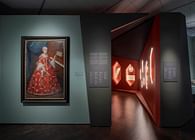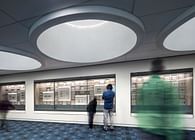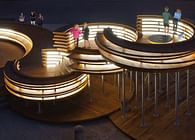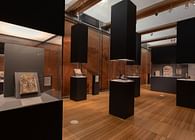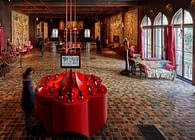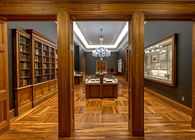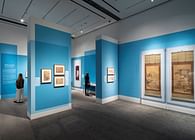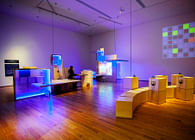
The Polaroid Project: At the Intersection of Art and Technology was an exhibition that featured 256 original works by 120 artists as well as over 103 artifacts including cameras, prototypes, tools, experimental films, and other technical materials.
The Polaroid Company, led by Edwin Land, was unique in that it embraced technology and art. Not only did Polaroid pioneer new technology (its most famous being the instant camera) that the world had never seen before, but Land also had the keen foresight to give away cameras and film to artists, encouraging them to create art that explored the creative possibilities of Polaroid products. The exhibition told the story of both.
The design was organized so that the “technology” (represented by the objects) was displayed in cases that formed a spine down the center, while the “art” (the artists’ photographs) was displayed along the perimeter of the galleries. The surfaces of the cases for the objects undulated, embodying the company history’s many triumphs and failures. This varied topography of the cases was actually achieved with only two variations of case types that were rotated in an alternating “pinwheel” fashion. Modular units enabled the design to be economical while being dynamic.
The perimeter walls took the form of bellows, suggesting the interior of both the SX-70 and 20x24 large format instant cameras. The bellowed walls were also functional, increasing the linear footage in order to accommodate the large number of photographs and also enabling the delineation of separate sections where the edges of walls exposed at the convex joints could be color-coded (one of the moments in the project where 3d and 2d design was integrated).
The most dramatic way in which 3d and 2d design was integrated was through the use of the rainbow. When the first instant camera debuted, it was received with much excitement, not unlike the iPhone when it first debuted. One of the most remarkable things about the instant camera was its “inclusivity.” For the first time in photography, the photographer and the subject were immersed in the creative process together. In the galleries, a bold and continuous rainbow graphic (inspired by the Polaroid One Step with a rainbow running down its center) was used at a large scale to convey this sense of excitement and immersion. Juxtaposed with the dark-colored bellow walls, the rainbow became a signature element of the show.
Functionally, the rainbow solved a myriad of design problems. Since the exhibition was on display in two adjacent but separate gallery spaces, the rainbow tied them together. Visitors would enter the exhibition at the space in between the adjacent gallery spaces. The rainbow served as a visual beacon, framing the title and creating a clear, bold entrance to the show. The rainbow also tied the object cases together; since the objects were presented chronologically, the linear quality of the rainbow allowed visitors to trace the trajectory of the Polaroid Company from its founding, through its ups and downs, and to its ultimate demise by following it from end to end. The rainbow also morphed into visitor seating, further encouraging the immersiveness of the exhibition experience.
Large format images mounted back to back on smoky plexiglass flanked the rainbow at several moments. These were inspired by polarized film, one of Edwin Land’s first inventions and the namesake of the company. When approached at an angle, the viewer would see each layer of the plexiglass separately, but standing directly in front of the prints made the plexiglass more opaque. This mimicked the effect of polarized film when viewed at and angle versus straight on.
Status: Built
Location: Cambridge, MA, US
Firm Role: Designer
